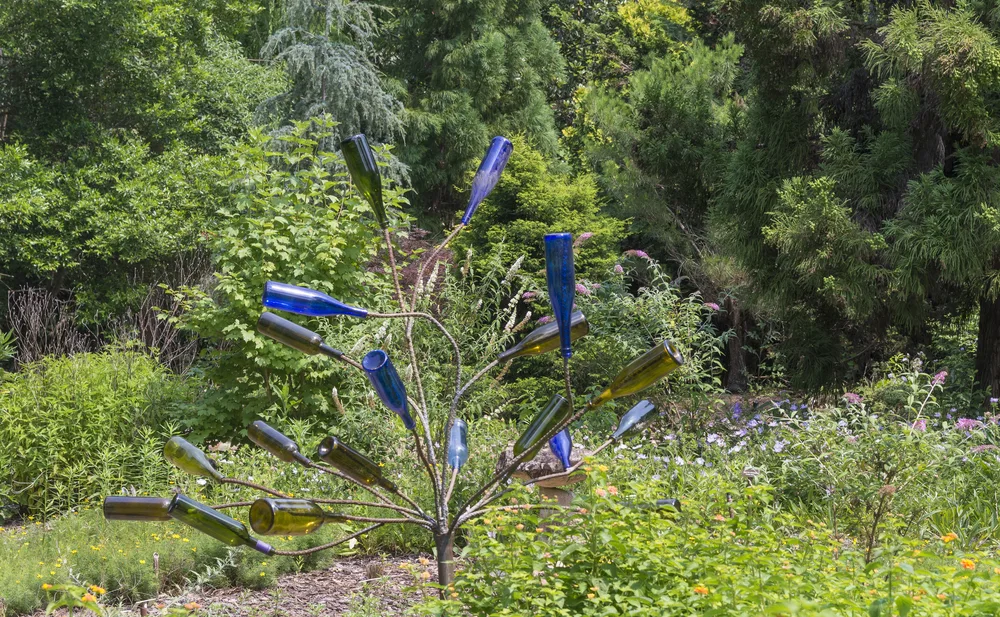Exploring the South of America, you might have noticed an unusual form of folk art in a yard or garden.
If you spot bottles arranged upside down atop tree branches or the arms of a metal stand, you’re witnessing what’s known as a bottle tree.

Traditionally, bottles were placed on crepe myrtle, a tree that has represented freedom since ancient times. Occasionally, cedar is used due to its resistance to decay.
Today, however, primary materials have been modernized to include metal rods inserted into a base and then secured in the ground.
Regardless of their composition, bottle trees serve as a tribute to Southern heritage, a respectful acknowledgment of ancestral generations, and a homage to history.
The Mississippi Encyclopedia, published by the University Press of Mississippi, suggests that the origins of the bottle tree tradition trace back to the ancient Kingdom of Kongo.
In the 9th century, bottles might have been utilized to mark burial grounds as part of funeral rites.
By the 17th century, during the peak of the Atlantic slave trade, displaced individuals continued the practice, marking graves while also fashioning bottle trees from whatever materials were available.
It was believed that sunlight reflecting through the colored glass attracted malevolent spirits, ensnaring them within and preventing their entry into nearby dwellings.
Another tale suggests that the glass lures spirits into the bottles at night where they are ensnared, only to be obliterated by sunlight come morning.
The belief in bottle trees forms part of a worldwide tradition
Smithsonian Gardens explains how bottle trees, once widespread in the southeastern United States, persist as a cultural, spiritual, and historical emblem today.
Cobalt blue remains the favored glass color as it symbolizes both water and sky, both drawing in and confounding spirits.
Aside from being positioned near homes, bottle trees were situated near significant gathering spots and crossroads to ensnare any wandering malevolent spirits.
The wind passing over a bottle’s mouth produces a mournful sound, purportedly indicating the entrapment of a spirit within.
Historically, bottle trees were found from eastern Texas to northern Florida, but the tradition migrated northward into Appalachia and farther south into Caribbean nations.
It’s noteworthy that the concept of glass ornaments warding off malevolent energy pervades stories worldwide, persisting for centuries.
In British folklore, the instrument for this purpose wasn’t a bottle but a witch ball, a hollow glass sphere. Hung at a residence’s entrance or in a window, a glass ball would ensnare a witch within or cause her to inadvertently curse her reflection.
Witch balls enjoyed popularity in 17th and 18th century England and were brought to New England during this period. Bottle trees represent just one iteration of this ancient tradition.
Even as we’ve become more acquainted with scientific principles, the notion of malevolent spirits lurking about to cause harm is often dismissed as superstition or folklore.
Yet, just because we now understand that certain conditions lead to illness and that germs cause infection, there’s no reason to entirely discard the magical beliefs held by past generations.
Installing a bottle tree in one’s garden today can serve as a tribute to our forebears
Crafting a tree is an acknowledgment of history and a form of culturally influenced art.
In any case, constructing one can be as respectful and profoundly meaningful as trees fashioned centuries ago.
As their popularity as folk art grows, instructions for creating new bottle trees are readily accessible.
Guidance from platforms like TikTok, YouTube, Pinterest, and the Farmer’s Almanac vividly demonstrate steps to fashion an authentic bottle tree in your garden.
A simple online search will also reveal where to purchase an entire tree from commercial vendors ranging from Etsy to Amazon.
Bloggers and landscapers who have erected bottle trees express their appreciation for the glinting colors amidst blooming flowers, akin to having a stained-glass window in one’s yard.
Even if a bottle tree doesn’t appeal to you, perhaps something else incorporating glass or color might. Overall, from bottle trees to sculptures, the garden provides an excellent canvas for showcasing artwork.
